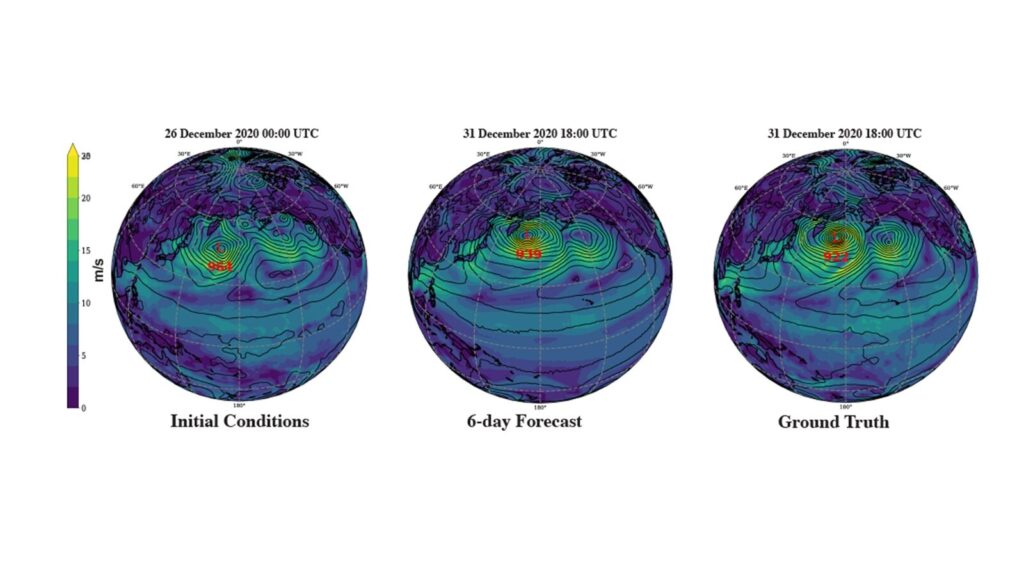Illustration of a six-day forecast of 10-m wind speed (color fill) and sea level pressure (shape) using the high-resolution version of Stormer (HR-Stormer) operating at 30-km horizontal resolution. Credit: Troy Arcomano/Argonne National Laboratory.
Being able to create accurate weather models for weather forecasting is essential to every aspect of the U.S. economy, from aviation to shipping. To date, climate models are primarily based on equations related to thermodynamics and fluid dynamics in the atmosphere. These models are computationally very expensive and are typically run on large supercomputers.
Researchers at private sector companies such as Nvidia and Google have begun developing large-scale artificial intelligence (AI) models for weather forecasting, known as foundation models. Recently, scientists at the US Department of Energy (DOE) Argonne National Laboratory, in close collaboration with researchers Aditya Grover and Tung Nguyen at the University of California, Los Angeles, have begun investigating this alternative type of model. This model can in some cases produce more accurate predictions than existing numerical weather prediction models at a fraction of the computational cost.
Some of these models extend the predictive ability of existing models beyond seven days, giving scientists an extra window into the weather.
Foundation models are built on the use of “tokens,” which are small bits of information that an AI algorithm uses to learn the physics that drive the weather. Many Foundation models are used for natural language processing, which means handling words and phrases.
For these large language models, these tokens are words or bits of language that the model predicts in sequence. For this new model of weather forecasting, the tokens are pictures — patches of charts that show things like humidity, temperature, and wind speed at different levels of the atmosphere.
“Instead of being interested in a sequence of text, you're looking at spatial and temporal data, represented in images,” said Argonne computer scientist Sandeep Medreddy. “When using these patches of images in the model, you get some idea of their relative positions and how they interact because of how they are labeled.”
The science team can use much lower resolution data and still make accurate predictions, said Rao Kottamarthy, an atmospheric scientist at Argonne.
“The philosophy of weather forecasting for years has been to get higher resolution for better predictions. This is because you're able to resolve the physics more accurately, but of course at a greater computational cost,” he said. comes,” he said. “But we're now finding that we're actually able to get results comparable to existing high-resolution models even at the coarser resolution with the method we're using.”
While near-reliable weather forecasting seems to be a near-achievable goal with AI, trying to use the same approach for climate modeling, which involves analyzing weather over time , presents an additional challenge.
“Theoretically, foundation models can be used for climate modeling as well. However, there are more incentives for the private sector to adopt new methods for weather forecasting than for climate modeling,” Kottamarthy said. are.”
“Work on foundational models for climate modeling will likely remain the domain of national labs and universities dedicated to finding solutions in the public interest.”
One of the reasons for climate modeling is that the climate is changing in real time, said Troy Arcomano, an atmospheric scientist at Argonne.
“With climate, we've gone from a largely stationary state to a non-stationary state. This means that all of our climate statistics are changing over time because of the excess carbon in the atmosphere. That carbon is also changing the Earth's energy budget,” he said. “Numerical detection is complex and we're still looking for ways to use AI.”
The introduction of Argonne's new exascale supercomputer, Aurora, will help researchers train a much larger AI-based model that will operate at much higher resolutions. “We need an exascale machine to be able to really capture a fine-grained model with AI,” Kottamarthy said.
A paper based on the study received the best paper award at the workshop “Tackling Climate Change with Machine Learning”. The workshop was held in conjunction with the International Conference on Learning Representation 2024 in Vienna, Austria on 10 May.
More information:
Nguyen et al. Measuring transformers for skilled and reliable medium-range weather forecasting. Tackling Climate Change with Machine Learning, ICLR (2024). s3.us-east-1.amazonaws.com/cli … iclr2024/7/paper.pdf
Provided by Argonne National Laboratory
Reference: New AI model predicts even higher accuracy from low-resolution data (2024, July 9) Retrieved July 9, 2024 from https://phys.org/news/2024-07-ai-high-accuracy-resolution.html can provide
This document is subject to copyright. No part may be reproduced without written permission, except for any fair dealing for the purpose of private study or research. The content is provided for informational purposes only.
